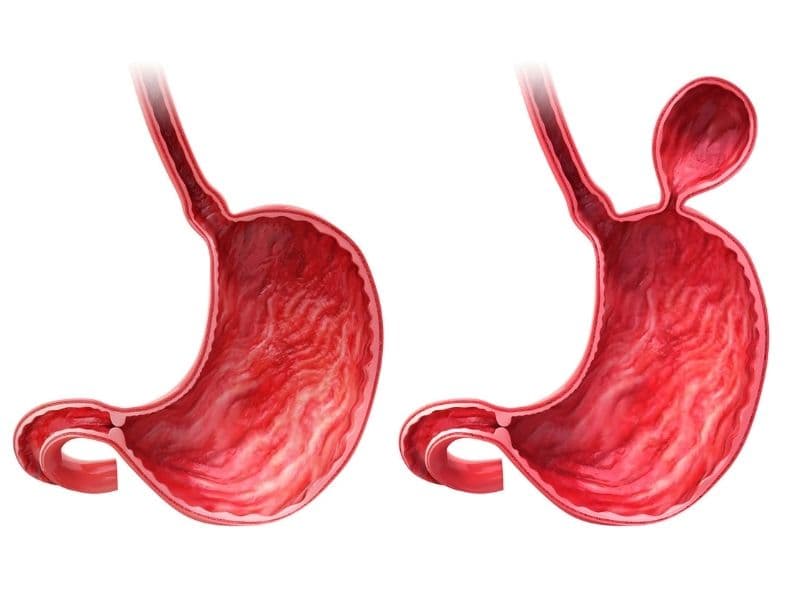A hiatal hernia, also known as a giant stomach hernia, is a condition in which the upper part of the stomach protrudes outward through the diaphragm and moves into the chest cavity. This shift in position can lead to various health issues.
There are different types of hiatal hernias, most commonly seen in older adults. The most frequent type is Type I, also called a sliding hiatal hernia. In this condition, the stomach slides upward and then shifts back down again.
Type II is referred to as a paraesophageal (rolling) hiatal hernia, where a bulge develops beside the esophagus. Type III is a combination of Types I and II, involving both sliding and paraesophageal components. Type IV is characterized by herniation that affects other organs as well.

What Are the Symptoms of a Hiatal Hernia?
Symptoms of a hiatal hernia do not always appear. If the problem is limited to a simple slide, it may be difficult to detect. In some patients, however, certain signs may be present:
- Acid reflux is one of the most common symptoms.
- A burning sensation in the chest and heartburn can occur.
- Patients may experience chest pain or discomfort.
- Even without eating, some patients feel full. Early satiety right after starting a meal is also common.
- Burning in the stomach may happen.
- Frequent belching and vomiting can occur.
- Gastroesophageal reflux disease (GERD) is one of the most frequent issues; stomach acid travels back up through the esophagus and may reach the mouth.
- Patients may have difficulty swallowing, feeling as if a lump is stuck in the throat.
- The throat can become irritated due to stomach acid.
- Some patients also report shortness of breath.
How Is a Hiatal Hernia Diagnosed?
A hiatal hernia is often discovered when patients consult a doctor with reflux complaints or during examinations for other conditions. One diagnostic method is a chest X-ray. Endoscopy is another commonly used technique. Additional diagnostic methods may include barium swallow radiography (also known as a barium esophagram) or esophageal manometry.
Hiatal Hernia Treatment Methods
The treatment for hiatal hernia depends on how severe the condition is. If the patient is asymptomatic, no treatment may be required. When patients have acid reflux, medication may be prescribed. However, those with more severe complaints than reflux might need surgery.
When Is Hiatal Hernia Surgery Necessary?
Surgical intervention for a hiatal hernia is considered when the symptoms are severe, or if the hernia is very large and poses a current or future risk. Surgery may also be recommended if medications are not sufficiently effective.
During surgery, the stomach is returned to its original position, and the opening that caused the hernia is closed. The procedure is typically done via laparoscopic surgery, resulting in very small incisions on the abdomen. From a cosmetic standpoint, this helps avoid large scars that might bother patients.
Recovery after surgery takes about six weeks. Patients are advised to follow a clear liquid diet initially and gradually transition to solid foods. Many patients lose about 4–5 kilograms after the operation. Most surgeries end successfully; however, it’s essential for patients to attend regular follow-ups. If the hernia recurs, another surgery may be necessary. Having the procedure performed by an experienced surgeon increases the likelihood of success.
Risk Factors and Causes of a Hiatal Hernia
Many people wonder, “Why does a hiatal hernia develop?” A key factor is a weakness in the tissues that separate the organs. This weak spot can create an opening that leads to the hernia. Possible causes of such tissue weakness include injuries or prior stomach surgeries. Stress and heavy work can also contribute to tissue weakness, allowing a hiatal hernia to form. In some cases, congenital defects are involved.
Chronic coughing or sneezing may also lead to a hiatal hernia. Additionally, chronic constipation and obesity are risk factors. Frequent vomiting can cause or worsen the condition. Intensive exercise, heavy lifting, pregnancy, and childbirth can also be underlying reasons for a hiatal hernia to develop.
Living With a Hiatal Hernia: Dietary and Lifestyle Suggestions
By paying attention to certain factors, you can maintain a better quality of life while living with a hiatal hernia. One important step is reducing meal portion sizes to decrease pressure on the stomach. Avoiding fatty foods is also essential. Refraining from eating late at night and sleeping with your head elevated are helpful strategies. People who smoke should consider quitting; giving up this harmful habit helps strengthen stomach muscles and lowers the risk of hiatal hernia.
The Link Between Hiatal Hernia and Reflux
If a hiatal hernia is left untreated, it can lead to complications. The most commonly observed complication is acid reflux, which can inflame the esophagus. As a result, patients may experience pain and difficulty swallowing, as well as potential ulceration and bleeding.
Barrett’s esophagus, a condition that changes the tissues lining the esophagus, may also develop in association with a hiatal hernia. Although Barrett’s esophagus in itself is not always a serious threat, it can carry a small risk of cancer. Doctors may opt for a biopsy to rule out any malignant changes.




